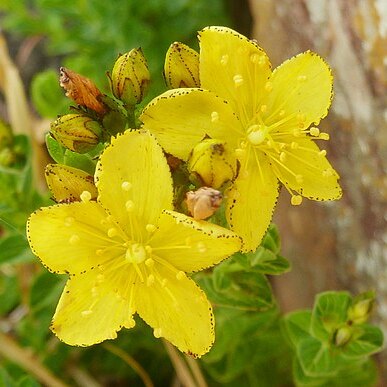Perennial herb, 0.04-0.50 m high; stems arise from underground crown. Leaves 8-23 x 4-15 mm, sessile, ovate, with translucent and dark glands. Flowers in few-to many-flowered cymes. Sepals 5-8 x 1.5-2.0 mm, ovate. Petals 10-13 x 2-4 mm; primrose-yellow. Stamens ± 50-70; irregularly arranged or in 3 or 4 distinct groups; filaments united at base; anthers with black or orange glands at apex of connective. Ovary ovoid; stigmas ± capitate. Flowering time Oct.-Feb. Fruit a capsule.
Leaves sessile, rarely shortly petiolate; lamina 5–25 × 3–15 mm., variable in shape and size, ovate, oblong or rotund, obtuse to rounded (rarely ± acute) at the apex, rounded to cordate-amplexicaul at the base, with margins often ± revolute, with numerous translucent glandular dots which vary in size, the larger ones prominent and yellowish, and dark glandular dots round the margins and sometimes elsewhere.
Stems erect, or decumbent at the base, tufted, unbranched, arising from an underground crown, (8) 10–45 (60) cm. long (usually 20 cm. or less in our area), or sometimes ± flattened or 2-lined above, eglandular or spotted with dark glands.
Petals (8) 10–13 (15) mm. long, 2–4 times as long as the sepals, primrose-yellow, usually red-tinged, with dark glandular marginal dots and dots or short streaks dispersed over the lamina (very rarely with only marginal dots).
Perennial to 30 cm with terete or flattened stems from a woody rootstock. Leaves spreading, ovate, margins often revolute. Flowers 1-many in a cyme, gland-dotted, yellow; sepals often glandular-haired.
Stamens c. 50–70, irregularly arranged or in 3 or 4 indistinct groups, with filaments ± united at the base; anthers usually with a dark or orange gland at the end of the connective.
Sepals lanceolate, acuminate or attenuate, subequal, with translucent glandular dots or short streaks, and dark glandular dots both marginal and dispersed over the lamina.
Flowers in lax or compact terminal few-to many-flowered cymes, rarely solitary; pedicels short (rarely exceeding 5 mm.), erect in fruit.
Ovary 3 (4)-locular; styles 3 (4), free, 3–6·5 mm. long.
Fruit capsular, 3–4-valved, erect.
Perennial herb.

